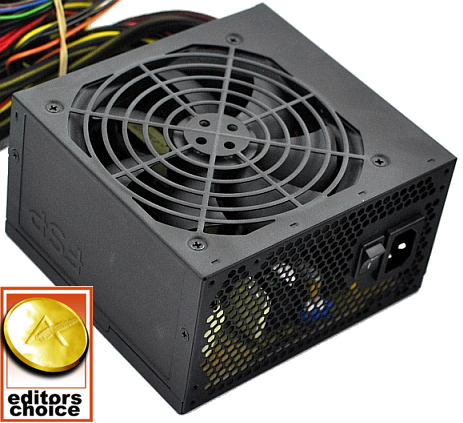350-450W Roundup: 11 Cheap PSUs
by Martin Kaffei on July 3, 2012 1:30 PM ESTConclusion
Some PSUs have no right to exist. The Sinan Power VP-430 430W at €22.40 (about $28) belongs in this classification if you want a reliable PSU. The Sinan Power is a ~215 watts power supply without active power factor correction—not to mention the fact that the efficiency is always below 75%. Sinan Power offers nothing more than three SATA and a few HDD connectors on very short cables. Once again it can be stated that you get what you pay for!
The be quiet! System Power 350W at €29.75 (about $37) is one of the 350W units we can recommend for Office use. The downside of the PSU is that there is no connector for graphics cards, but this shouldn't hurt too much. Three SATA and HDD connectors are provided and there is a floppy connector at 75cm. be quiet! uses Taiwanese capacitors like most manufacturers in this roundup. be quiet! will be finally entering the US market later this year which is a good news for enthusiasts as they deliver the quietest PSUs in Germany.
Thermaltake offers a few power supplies which come up to expectations but the Thermaltake Smart AP-430P 430W at $61.99 didn't do well as the efficiency was low. 83.64% is the highest value we measured during the test. During 20% load Thermaltake didn't even surpass the minimum requirement for 80 Plus. You get the usual set of accessories and cables, but there are no unique features or remarkable results, which should be mentioned.
The Rosewill Green Series RG430-S12 430W at $44.99 provides many connectors except the PCI-E plugs. The model reached up to 84% efficiency and more than 40mV ripple and noise on the smaller rails. This should be avoided next time. However, the PSU stays stable all the time and comes with several extras such as cable ties. In summary, the RG430-S12 is a decent mainstream PSU.
The OEM models by FSP (FSP400-60APN 230V version and FSP400-60GHN(85)) performed well in our test. All the modern FSP PSUs we've reviewed have no problems with ripple and noise, and that trend continues here. However, both models provide just a 4-pin CPU connector and 6 to 9 peripheral plugs. Additionally, you get only one 6-pin connector for graphics cards. Like most PSUs in this roundup both models have all important safety functions including OCP and a common forward converter. All in all we have to criticize the cable configuration, which plays an important part when building a PC.
| Comparison: Max. Efficiency | |
| PSU | Efficiency (230VAC) |
| FSP Raider | 90.54% |
| FSP400-60GHN(85) | 86.76% |
| Enermax NAXN | 86.39% |
| Rasurbo RAP | 86.27% |
| be quiet! System Power | 85.86% |
| Corsair CX430 V2 | 84.90% |
| FSP400-60APN | 84.64% |
| Rosewill Green Series | 83.73% |
| Thermaltake Smart | 83.64% |
| Sinan Power VP-430 | 74.13% |
The Corsair CX430 V2 430W at $39.99 is an affordable power supply with low ripple on all rails. The number of connectors and their distribution is satisfying as well. During the load test the regulation of the output voltage is sufficient, and the efficiency is decent for an 80Plus model. The contents of the package are also very welcome. The power supply uses a well known layout from CWT and it's a cheaper design. The relatively low-end capacitors are acceptable for a PSU in this range. Under load the power supply is clearly audible, reaching up to 27 dBA.

The Rasurbo RAP350 350W at €30.84 (about $39) and RAP450 450W at €43.59 (about $55) use Taiwanese capacitors from Teapo, there's a lot of space for cooling and airflow, and they've chosen better MOSFETs than Thermaltake. The RPMs are tolerable up to 50% load causing a low fan noise. In terms of voltage stability, the 3.3V rail measures 3.19V during our overload scenario. All the other outputs are closer to their optimal values. The package includes all important extras and 86% efficiency is pretty nice. In addition there are two PCI-E connectors at the 450W model. We are pleased to present Rasurbo with our Bronze Editors' Choice award.

The Enermax NAXN ENP450AWT-B 450W (no price available) is very efficient and stable. In addition Enermax provides one more SATA connector and longer cables than Rosewill which is usually more important than a few additional HDD plugs. There is no heavy increase in acoustic noise during operation, but the fan already starts at a high RPM. Beside this we couldn't find any major flaws. Inside we found the same double forward topology Corsair used. However, Enermax has more efficient components and the cable configuration is more extensive. In addition the NAXN used a better looking cable sleeving, probably the best in this roundup. Enermax also performed well, reaching low ripple and noise results and an ideal voltage regulation. Last but not least we can recommend the PSU because of features like the HeatGuard and many safety functions. Enermax deservedly earns our Silver Editors' Choice Award for providing a (nearly) flawless product.
The FSP Raider 80Plus Bronze 450W at a MSRP of $55 is the most expensive PSU in this roundup for the simple reason that they offer the best product. FSP provides two PEG connectors instead of one (which is enough to run either a lower-end SLI/CF setup or a single high-end graphics card with two PEG jacks), a 5-year warranty and a very high efficiency. In fact the efficiency was ~4 percentage points above the second best result (230VAC) and way above the necessary values for 80Plus Bronze (Silver at 115VAC, Gold at 230VAC). FSP integrated well chosen components and the well known active-clamp design. Moreover FSP implemented all safety functions including OCP. Five SATA connectors and a very long CPU cable perfect the PSU. The fan's RPM and the load rise equally, but the noise is still acceptable compared to the Aurum models. We’re awarding FSP our Gold Editors’ Choice award.











67 Comments
View All Comments
Phaedrus2129 - Thursday, July 5, 2012 - link
That Sinan PSU is likely made by LongYi, a small and crappy PSU manufacturer in Guangdong, China. They make knock-off, cost-down designs based on reverse-engineered FSP and similar PSUs.Martin Kaffei - Thursday, July 5, 2012 - link
Thanks for these information. I guess there are more brands who use this manufacturer so it wasn't useless to test a German product.hasseb64 - Thursday, July 5, 2012 - link
Not many need more than 400W anymore, some think it's better to buy more now to be sure about future upgrades, but that view is should be reversed, total watt consumtion in builds going down for every generatio. I hope to see Platinum/Gold PSU from 200-300W in the future.Owning:
460W GOLD ATX
300W Gold ATX
bryanl - Thursday, July 5, 2012 - link
"The Teapo models don't have the longest lifetime and lowest ESR; however, we've never detected a problem with Teapo in power supplies."Official ratings mean little when they're not honest, and while I haven't looked at Teapos in recent power supplies, they had very high failure rates in older CWT supplies, including those sold as Antec Smartpowers and Truepowers.
Martin Kaffei - Thursday, July 5, 2012 - link
True, but Teapo has several products, you can't compare old models with current offerings. And some ratings are wrong for sure, but most manufacturers in this roundup used the same series and some of this companies have less than 1% failure rate according to retail shops.Not least you can't compare old PSUs with a modern 80Plus device. Temperatures are much lower today and switching frequency is different (which is why a low-ESR model would have been nice anyway). The ambient conditions are different. Teapo had problems on mainboards for the same reason. There are no bad or good components, just the right choice for a specific range of functions.
bryanl - Thursday, July 5, 2012 - link
"True, but Teapo has several products, you can't compare old models with current offerings. And some ratings are wrong for sure, but most manufacturers in this roundup used the same series and some of this companies have less than 1% failure rate according to retail shops.Not least you can't compare old PSUs with a modern 80Plus device. Temperatures are much lower today and switching frequency is different (which is why a low-ESR model would have been nice anyway). The ambient conditions are different. Teapo had problems on mainboards for the same reason. There are no bad or good components, just the right choice for a specific range of functions. "
These were mostly Teapo SC (green w/ gold or bronze writing), as new as 2010, a product still being made. What model Teapos were you thinking of?
I believe these operated at frequencies of 60K-100K Hz and averaged temperatures of 50-65C. What are the operating conditions of the capacitors in the 80Plus power supplies?
Power supplies will often continue to operate adequately even years after capacitor failure since some capacitors are redundant, including with motherboard capacitors, and most computers draw little power.
Martin Kaffei - Friday, July 6, 2012 - link
Even then it might be that Teapo changed some ingredients.However, let's assume that this is not the case. Current PSUs switch much faster than 100 KHz in order to reduce component size. E.g. 250 KHz is a common value these days, some of them are even faster. This is just one out of many different conditions:
"averaged temperatures of 50-65C."
No matter where--it will be lower, but where did you measure these temperatures? On which outputs or circuits did they fail? Did they all fail? Is there more or less space for cooling than in most PSUs in this review? How high was the average ambient temperature during operation? Do these PSUs have the comparable ripple values? How high was current? How high was load?
This and even more is what we need to evaluate the position.
For sure PSUs can operate without some of the output capacitors, but not for ever and ever. There are signs. In many cases you can hear noises when capacitors fail (or measure something). Moreoever I've never seen faulty Teapo capacitors in old FSP units and I used plenty of them for years.
The source of such problems can be elsewhere. I had a PSU with an oscillating controller and all capacitors on 5VSB died. Does this mean the capacitors are the problem? No, after replacing a single resistor the controller was stable and the caps didn't fail again.
bryanl - Friday, July 6, 2012 - link
"RE: Capacitors in Rosewill power supply by Martin Kaffei on Friday, July 06, 2012 Even then it might be that Teapo changed some ingredients.However, let's assume that this is not the case. Current PSUs switch much faster than 100 KHz in order to reduce component size. E.g. 250 KHz is a common value these days, some of them are even faster. This is just one out of many different conditions:
"averaged temperatures of 50-65C."
No matter where--it will be lower, but where did you measure these temperatures? On which outputs or circuits did they fail? Did they all fail? Is there more or less space for cooling than in most PSUs in this review? How high was the average ambient temperature during operation? Do these PSUs have the comparable ripple values? How high was current? How high was load?
This and even more is what we need to evaluate the position.
For sure PSUs can operate without some of the output capacitors, but not for ever and ever. There are signs. In many cases you can hear noises when capacitors fail (or measure something). Moreoever I've never seen faulty Teapo capacitors in old FSP units and I used plenty of them for years.
The source of such problems can be elsewhere. I had a PSU with an oscillating controller and all capacitors on 5VSB died. Does this mean the capacitors are the problem? No, after replacing a single resistor the controller was stable and the caps didn't fail again. "
250 KHz has long been common for motherboards, but which PSUs oscillate near that frequency? I wasn't able to find anything operating above approximately 150 KHz at websites that presented oscillographs (Jonnyguru.com, Hardwaresecrets.com) where the fundamental could be identified. Temperature readings were taken with direct contact thermistors or thermocouples touching the metal bodies of the output capacitors while the PSUs operated motherboards without high performance video cards.
In well designed power supplies, few components fail nearly as much as capacitors, and there's a fairly common +5VSB circuit made of 2 discrete transistors that overvolts when it fails, almost always due to a bad capacitor, often 1-2 10V, 1000uF Teapo SCs.
Bambooz - Sunday, May 5, 2013 - link
Forget about Teapo. C(r)apxon is the biggest epidemic right now. They're in basically every Fortron and Fortron based PSU (Bequiet anyone?)If you have a PSU with Crapxon on the secondary side it's almost guaranteed it won't make it to it's 2nd birthday without the crapxons puking their guts out and in turn, sh*tloads of ripple (I've had client computers where shitty cheap FSP OEM PSUs killed HDDs due to their caps failing)
Instability, whining and sometimes (for example Bequiet E5 series and FSP Bluestorm I & II) power-up problems (because of bad caps on the 5VSB circuitry) are pretty much the norm with these..
No matter how good fortrons may sound.. avoid them at all costs unless you can recap them BEFORE putting them into service.
Onus - Thursday, July 5, 2012 - link
I too am interested in lower-wattage units, so this article was a good read. I've been more impressed with FSP's recent offerings. The way the Raider's efficiency quickly ramped up was excellent. Maybe not down to the Picos, I am also interested in physically smaller units, like TFX and SFX models. Seasonic and FSP have some good ones there.My "goto" PSU in budget builds for years has been the Antec EA-380D. I've never had one fail. I buy Seasonic or Antec for my own systems, although I'd consider FSP, Corsair, or Enermax also.
If you go through the assortment of reviews Gabrial Torres at HardwareSecrets has done on CM PSUs, you will understand why I call them "Crappermaster." The "Extreme ..." lines in particular are near-junk, most with liar-labels and/or claimed protection circuits actually missing. That's consumer fraud. One of my favorite comments though comes from a HardOCP review, in which the GX650 was summarized as a "polished turd in a box." Friends don't let friends buy Crappermaster (even their good stuff, because that is supporting a dishonest business).